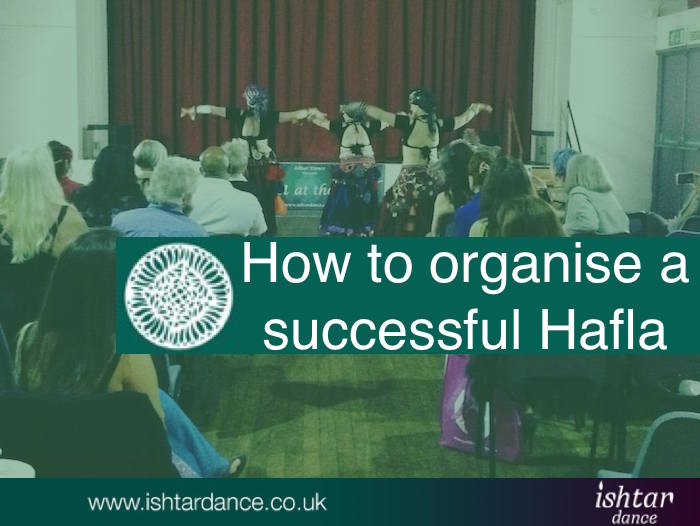How to organise a successful Hafla
By Ishtar Dance on Monday, August, 21st, 2017 in Dance Entrepreneur, Dance Inspiration, Hafla at the Hall No Comments

For the past 6 year’s I’ve been organising Hafla at the Hall in Weybridge, Surrey. It has gone from being a small community event to a well-known and much loved showcase attracting performers from all over the UK. On Friday 18 August 2017 we celebrated the last ever Hafla in THE Weybridge Hall. Many told me it was the best event to date, but that’s often how it goes; it takes years to hone your hosting skills and build up a reputation. So in this week’s blog I want to share what I learned over the year’s, so you can organise a successful Hafla more easily.
Each Hafla is obviously different, as they in some aspects reflect the personality of the organiser(s), but the venue is also hugely important. Before you even get started you should ask yourself a few key questions: what do you want to achieve with your event? Will it be to engage the local community? To raise funds for charity? To raise your own profile in the belly dance community? Or maybe all three or more reasons?
Make a plan, or rather a wish list, for how you see your event developing over the next 3-5 year’s. Will you host it annually? Bi-annually or perhaps even monthly? Will you have the time and resources to do so? Do you want to start slow and then build it up to become more of a regular thing? Once you have your ideal scenario set out it’s time to start looking at the nitty gritty of it all.
A Wonderful Venue
Your venue is key to your event. You want to have a solid base for your event, unless you’re planning more of a roadshow Hafla (which is a great idea too!). It obviously has to have a suitable floor and space for the dancers. The space itself has to be big enough for your intended audience (ideally also as it grows over the years), it has to have good basic facilities, such as toilets, rooms for the performers to change, a kitchen or bar for refreshments, as well as decent lighting and disabled access. But the atmosphere is also key. Many choose to set up their showcase in Middle Eastern restaurants, and it’s a lovely idea if the staff and facilities are right. But you really don’t want dancers getting humous all over their costumes because they have to navigate past waiters or dirty tables on their way to and from the performance area…
Location, Location, Location
As essential as your venue looks and feels, so is also its location. Is there sufficient parking for those coming by car? Is it possible to get there by public transport? If so, make sure you let people know this, and that it’s easy to understand just how close it is to other key transport hubs such as main rail stations or wellknown tube stations, if you’re in a major city like London. Are there good local facilities too, such as restaurants, cafes, or even B&Bs for dancers who come from further afield? Alternatively, are you happy to put them up in your house for the night of the Hafla?
Setting Up
Your venue, as well as your theme, will decide how much you set up to make your Hafla the amazing and welcoming event that you’re planning. Will you provide drinks and snacks? Will you charge for these? Will you have tables as well as chairs? Will you need to decorate these? If you have a noisy hall with lots of echo you may want to invest in some cheep table cloths to improve the acoustics. Candles are great for atmosphere, but will your venue hirer policy allow these for health and safety reasons? Do you need a separate insurance to host your event? Many public halls will include this in the hirer, but for all other venues, including restaurants and bars, it’s a good idea to check this with the owner beforehand, as legal costs for a possible accident could set you back significantly.
Will you have a stage? Will it need a backdrop? And how about a sign for branding? You want to get your event’s name out there, so getting a sign or banner in the photos of the dancers is an effective and easy way for you to do. I’ll write more about this in future posts about basic marketing for belly dancers.
Sound System
Whether you need one will depend on your venue, but a good sound system is key to hosting a memorable and successful show. Make sure your loudspeakers are up for both playing up your dance space, but also handling the complexity of Egyptian music. Many cheaper lower range speakers have to much base and too little higher note range, so if you need to purchase make sure to try before you buy, and also get to know how to use your amplifier to its full potential. Make sure to have a relatively technical person handling the music and sounds system on the night, as there are always likely to be a few glitches.
The Line Up
You may know enough local dancers to fill your programme, but it’s always a good idea to get some from further a field to attend as well. New faces provide lots of inspiration for your audience, and there’s nothing worse than seeing the same dancers, in the same costumes, dancing the same choreographies, to the same music. Try to get a bit of variety and don’t be afraid to invite dancers you don’t know. Ask them to send you a link of them dancing, so you can check out their level if you want to make sure they fit your bill. I always put student and relative new performers at the beginning of the show so that:
a) they can get their performance out of the way, and then they can sit back and enjoy the show
b) the programme builds throughout the evening. As a new or student performer it can be very nerve racking to perform after someone semi-professional, so by building up to the more professional dancers you both allow the more inexperienced dancers to feel less pressured, whilst also taking the audience on a bit of a journey. But do mix it up too, so the show keeps its momentum and the audience’s interest.
Do always slightly overbook, as there’s a 99% risk that someone will have to pull out on the night – either due to illness, injury or car trouble! But do also be realistic with your timings. Make sure you set a limit on each dancers music (say max 5 minutes), so that they don’t all want to dance for 10 minutes each. Then calculate the length of the show before adding in any time spent introducing the performer. Make sure to allow for a break or two depending on the length of your show, so the audience can mingle and have a chat about the wonderful dancers they are seeing. Ten to twelve performances is probably all that your audience will have concentration (and bladder capacity) for in one go, although everything is relative…
Selling Your Tickets
Early bird reduced rate tickets will hopefully ensure you get your audience to commit and you get some money to pay your expenses. Many sell these via their website’s shop page, but you can also use online booking sites such as eventbrite (that take a percentage for doing this). Getting your dancers or fellow organisers to sell tickets in person is also an easy way to distribute tickets, as well as advertise the event without extra costs. Do make sure you keep track of how many tickets you have sold, and who has done so, if several people are selling on your behalf.
Photography & Videos
Most Hafla’s have an official photographer and videographer, so that performers can buy some nice (and non-blurred!) photos of themselves afterwards. In recent years fewer and fewer videos have been sold, as most performers will have someone in the audience filming for them. But if you’re planning to promote your event afterwards, some good video footage is key. Even if it’s done by someone in the audience sitting in a prime position, so try to get this box ticked before the night.
Music
Get your music beforehand so you can set up a playlist in the right order ahead of the event. This may sound obvious, but can be a lot harder than you think. Allow for plenty of time for the performs to get back to you, and then allow for some extra time to chase a few for their music in the right, edited (if necessary) format. Do always have back up too! Your iPod, computer or other device can fail. So try to either burn it on CD, or bring another iPod, memory stick etc. on the night. To make 200% sure, I always ask the dancers to also bring their own back up on the night. That way no performance has to fail due to music problems. Do also make sure that you, or your DJ, gets information from the dancers about whether they start on or off stage, whether they will be needing any props that you may need to supply (or remove) etc. If possible do also make sure you listen to the music beforehand, so you know if it works, the sound levels are ok and if it all fits together in the line up.
On the Night
Dorte
Did you miss my last post? Read it here: Why you need a belly dance network

Leave a Reply